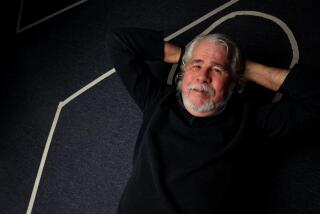‘Chaplin’s Essanay Comedies’ took some doing, but it completes the Chaplin Project
- Share via
In less than a year at Mack Sennett’s Keystone Film Co. in 1914, Charlie Chaplin had gone from a member of the stock company to one of the studio’s brightest lights.
He had developed his character of the Tramp and was writing and directing short films. And even though Sennett never publicized the names of his actors, Chaplin’s name would often appear in ads for the films.
After his year contract expired, the 25-year-old Chaplin signed a lucrative one-year contract with the Chicago-based Essanay Film Manufacturing Co. for $1,250 per week and a signing bonus of $10,000. Essanay was created in 1907 by George K. Spoor and G.M. Anderson, best known as cinema’s first major cowboy star, “Broncho Billy” Anderson.
SIGN UP for the free Classic Hollywood newsletter >>
The 14 films Chaplin made during 1915 include what is considered his first classic, “The Tramp,” as well as “A Night in the Show,” “The Bank” and “A Night Out.”
Flicker Alley and the Blackhawk Films Collection have recently released the DVD/Blu-ray “Chaplin’s Essanay Comedies.” The set is the third and final installment of the 12-year Chaplin Project, led by Lobster Films in Paris and Cineteca di Bologna to digitally restore the silent comedies Chaplin made from 1914 through 1917.
Chaplin’s Keystone films were released five years ago, and his 1916-17 Mutual comedies featuring such masterpieces as “The Immigrant,” “The Vagabond” and “Easy Street” came out a year ago.
Just as with the first two sets, the restored Essanay comedies are stunning as are the scores by Robert Israel, the Mont Alto Motion Picture Orchestra and Timothy Brock.
Restoring the Essanay comedies was complicated because the company floundered after Chaplin left and ceased to exist by 1918.
“No original negatives were known to survive of the Essanay comedies,” said film archivist and historian Serge Bromberg of Lobster Films. “It was a miracle we found the last surviving camera negative for ‘The Bank.’”
Unfortunately, only one original nitrate reel of the comedy preserved by UCLA Film & Television Archive survived. According to Bromberg, they had to use a nitrate print from the collections of the Museum of Modern Art, “a print decomposing from the Library of Congress and an ugly Russian print that was in the Brussels’ archive. It took those four prints to reconstruct the print finally.”
Though they had prints and negatives coming from around the world, Bromberg said the project was “very, very fortunate” that the Museum of Modern Art had bought a set of early nitrate prints of the Chaplin negatives from a distributor in 1939.
Chaplin’s year under contract at Essanay was not pleasant. “Essanay was a company based in Chicago,” said Bromberg. For Chaplin, the snow and cold of the Windy City wasn’t to his likening. So Essanay sent him to Niles near San Francisco to make his comedies, and eventually Chaplin returned to Los Angeles to complete his contract.
Spoor, who supplied the financing and was the company’s manager, originally didn’t want to sign Chaplin because he thought Chaplin was too expensive. “But Anderson convinced him,” said Bromberg.
Spoor also didn’t want Chaplin “to get too much power in the company,” noted Bromberg. “Chaplin wanted to do his own films,” Bromberg noted. Spoor felt: “If pie fights would sell, why stop doing pie fights?”
So though there is plenty of slapstick in these films, Chaplin’s artistry begins to shine especially in “The Tramp,” in which the vagabond saves a beautiful farmer’s daughter (Edna Purviance) from thugs who want to rob her. He falls in love with her only to discover she has a boyfriend. “Tramp” marks the first time a Chaplin film ended on a sad note, with him shuffling down the road as the scene fades out.
He had found Purviance in San Francisco, and they quickly became a couple on and off the screen. “When you watch a film like ‘The Tramp,’ there are not many jokes, but it’s so romantic,” said Bromberg. “Obviously, he was very, very much in love with Edna.”
Bromberg is especially proud of “Burlesque on Carmen,” a two-reel spoof of Cecil B. DeMille’s “Carmen.”
“Chaplin shot the film and left it behind,” said Bromberg. “The editing was not complete, so Essanay decided to extend the film to four reels by shooting random scenes that are absolutely pointless.”
The filmmaker sued Essanay. Though Chaplin lost, he did describe in detail his vision for the film. “They shot the other sequences with a different camera,” said Bromberg. “So it was very easy to see what Chaplin wanted to do. We have what Chaplin wanted minus a few shots that did not survive.”
More to Read
Only good movies
Get the Indie Focus newsletter, Mark Olsen's weekly guide to the world of cinema.
You may occasionally receive promotional content from the Los Angeles Times.









